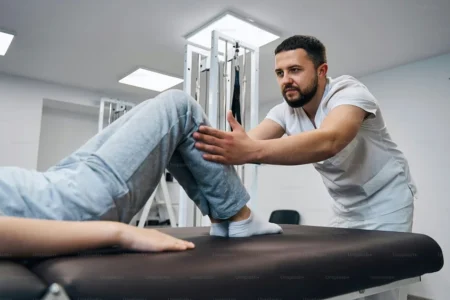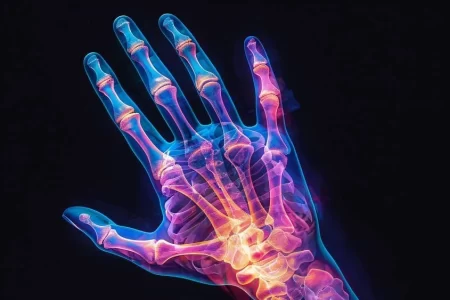
The thumb involves a breadth of movement to perform tasks that are unique in human, from powerful grasp to fine pinch. The joint morphology of the metacarpal bones on the trapezium (a carpal bone below the base of the thumb) affords this functional spectrum. Although in circumduction it acts like a ball and socket, providing close lateral pinch to the index finger or wide prehension of large objects within the palm.
What is thumb arthritis?
Thumb arthritis is a condition when cartilage wears away from the ends of the bones that form the joint at the base of the thumb, called as the carpometacarpal (CMC) joint. As a result, bones rub together, creating friction and harm the joint, causing pain and other symptoms. According to the American Academy of Orthopedic Surgeons, thumb arthritis usually occurs with aging. Thumb arthritis is also known as basal thumb joint arthritis.
Thumb arthritis symptoms
The first and most common symptom of thumb arthritis is usually pain at the base of the thumb when a person grasps or touches an object. A person with thumb arthritis may also feel thumb pain whenever they apply force using the thumb.
Other symptoms of thumb arthritis include:
- swelling at the base of the thumb
- arthritis in the thumb knuckles
- arthritis pain in thumb, discomfort, or tenderness at the base of the thumb
- restricted range of motion in the thumb joint
- the inflamed, bony-looking joint at the base of the thumb including osteoarthritis thumb
- loss of strength in the thumb joint that causes severe thumb joint pain
Symptoms may vary in cases. Symptoms may be mild at first then get worse in due course, especially if a person is left untreated.
Causes and risk factors involved in thumb arthritis
Most cases of thumb arthritis involve a type of osteoarthritis of thumb, which means it is due to degeneration of cartilaginous covers from knobby ends of a bone. Since thumb arthritis most commonly develops as part of the normal aging process, it is more common in adults over 40 years of age. People who have had previous fractures or injury to the thumb joint are also more likely to progress thumb arthritis or basal thumb arthritis.
Other risk factors that may make an individual more prone to develop thumb arthritis include:
- obesity
- physical activities that stress the thumb joint
- computer work for extended hours
- diseases affecting the cartilaginous tissue, including rheumatoid arthritis
Diagnosis of thumb arthritis
During a physical thumb exam, your orthopedic physician may ask about your symptoms and look for evident swelling or lumps on your thumb joints. The doctor may hold your joint while moving your thumb, with pressure, against the wrist bone. If this applied pressure produces a grinding sound or causes pain or a gritty feeling, the cartilage has likely been damaged or give the sensation that may indicate that the bones are rubbing together leading to thumb pain or thumb joint pain.
X-rays and other imaging techniques can reveal indications of thumb arthritis, including such as:
- bone spurs: bony projections usually develop along the edges of the bone
- calcium deposits
- wear and tear of cartilaginous tissues
- narrowing of the space between the ends of the bones in the thumb joint
Treatment of thumb arthritis
The severity of a person’s thumb pain can help a doctor to establish a better treatment plan. According to the American Society for Surgery of the Hand, there is no medication available that can lower the progression of arthritis in the thumb. X-rays demonstrate that basal joint arthritis usually gets worse with time. The rate of the progression of osteoarthritis in thumb varies from one person to another. But some treatments may help alleviate the symptoms. Potential treatments that may provide thumb arthritis relief include:
- thumb brace for arthritis
- thumb arthritis exercises to strengthen the muscles around the thumb
- anti-inflammatory medications
- steroid injections into the basal joints
- occupational or physical therapies
- applying heat or ice to the thumb joint
- ergonomic adjustments to relieve arthritis pain in thumb
- shun the activities that put pressure on the thumb
Medication to relieve pain from thumb arthritis
To relieve pain, your doctor might recommend:
- Topical medicines which are applied to the skin over the joint such as capsaicin or diclofenac.
- OTC pain relievers, such as acetaminophen, ibuprofen or naproxen sodium
- Prescribed pain relievers including celecoxib or tramadol
Thumb splints for osteoarthritis or basal thumb joint brace
A splint may support the joint and checks the movement of the thumb and wrist. It is advised to wear a splint at night or throughout the day. Splints help:
- in alleviating pain
- support proper positioning of the joint while you complete everyday jobs
- relax your thumb joint
Injections to relieve pain from arthritis in thumb joint
If pain relievers and a splint aren’t efficient, your health care professional might advocate injecting a long-lasting corticosteroid into the thumb joint. Corticosteroid injections are capable of reducing inflammation and provide temporary pain relief.
Basal thumb arthritis alternative treatment may involve the use of Dextrose Prolotherapy Injections.
Basal thumb arthritis surgery
A doctor may recommend surgery if other treatment options do not work and the symptoms get worse. Thumb arthritis surgery includes following surgical procedures:
- Ligament Reconstruction and Tendon Interposition: The thumb arthritic joint surfaces are removed and replaced with a cushion of tissue that keeps the bones apart. To accomplish this, orthopedic surgeon removes all or part of the trapezium bone in the wrist.
- Arthrodesis (joint fusion): The bones in the affected joint are permanently fused. The fused joint can bear weight without pain but has no mobility.
- Osteotomy: The bones in the inflamed and affected joint are repositioned to help correct deformities.
- Trapeziectomy: One of the bones in your thumb joint (trapezium) is usually removed.
- Basal joint arthroplasty (joint replacement): All or part of the affected thumb joint is removed and replaced with a graft from the tendons.
It may take several weeks or even a year to recover from thumb surgery. After surgery, you may be advised to wear a cast or splint over your thumb and wrist for a few weeks. During this time, a person may receive rehabilitation services from physical therapists.





